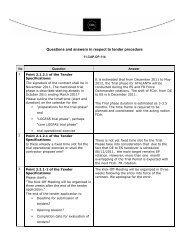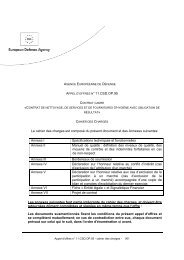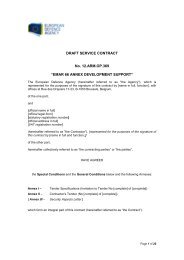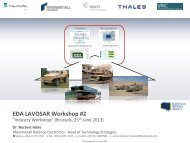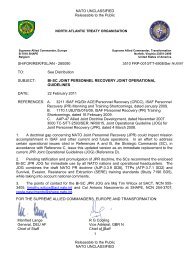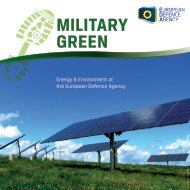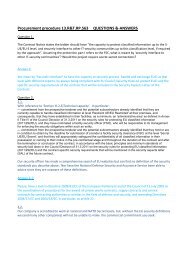capability development plan - European Defence Agency - Europa
capability development plan - European Defence Agency - Europa
capability development plan - European Defence Agency - Europa
You also want an ePaper? Increase the reach of your titles
YUMPU automatically turns print PDFs into web optimized ePapers that Google loves.
THREATS AND CHALLENGES DERIVING FROM<br />
POTENTIAL ADVERSARIES<br />
and tele-medicine.<br />
33. Adversaries may use differing vaccination policies to target the part of the forces with lowest<br />
immunisation levels.<br />
34. The use of hijacked ships or similar weapons to EU forces to create the impression of a major<br />
environmental incident (such as 9/11) may not be ruled out within theatre or within Europe.<br />
35. Temporal. Adversaries will attempt to dictate where and when the integrated fight takes place. At<br />
critical times of his choosing and preferably at a location that allows him to capitalise on his strengths<br />
while minimising his vulnerabilities.<br />
36. Adversaries' improved situational awareness and advanced intelligence will provide them with an<br />
increased ability to influence the tempo of operations.<br />
37. In very complex and rapidly evolving mission situations, the decision-making process will become<br />
highly time-critical. An inability to provide timely mission instructions from remotely located command<br />
may result in mission failure or in casualties to both force personnel and civilians. On future<br />
battlefields, even lowest-ranking soldiers may be faced with complex spectrum of challenges.<br />
38. Positional. Adversaries are likely to conduct operations from areas of moral and physical<br />
sanctuary, e.g. command posts established within civilian hospitals.<br />
39. Adversary targets and key sites may not be in the joint area of operations. They may develop<br />
capabilities to engage assets even at home base (global threats) and are likely to engage EU forces,<br />
their assets and infrastructure at home base (terrorist threat, IEDs) and by that way could try to<br />
interfere with deployment of EU troops and assets.<br />
40. Potential poor road infrastructure and long distances will provide the adversaries with plenty of<br />
opportunities to try to engage EU forces by use of various means: e.g. CBRNE agents, weapons and<br />
devices, displaced persons, virtual and false mines (incl. sea mines), and robots.<br />
41. Operations in urban environment will be more challenging as the adversaries will have plenty of<br />
opportunities to try to limit EU forces’ ground mobility. In addition the adversary may be less dependent<br />
on ground mobility (e.g. use of UAVs / modern communications).<br />
42. Adversaries will try to take benefit from hiding amongst civilian population, refugees, displaced<br />
people, etc. and therefore identifying adversaries may be difficult. This may include the use of civilian<br />
infrastructure to conceal military targets and thus make their engagement more difficult (collateral<br />
damage).<br />
43. Adversaries will try to attack, or limit access to, lines of communication/lines of supply and points<br />
of deployment (APODs and SPODs), and may try to limit EU forces’ access to Host Nation Support<br />
(HNS). In particular, this may apply to staging areas within third countries.<br />
PRINCIPLE OF DISTRIBUTION AND CONCENTRATION<br />
Concentration is the garnering of combat power in order to apply it at a specific time and place.<br />
Distribution is the dispersal of forces and effort, geographically and by time, in order to achieve the<br />
required effects - apportioning forces to achieve specific objectives. This is highly reliant upon<br />
knowledge - intelligence and technological.<br />
The more that is known then the faster and more confidently forces can be concentrated where and<br />
when required. Adversaries will have access to modern combat power (i.e. 2nd generation MBT,<br />
attack helos, 4th generation combat aircraft).<br />
© sxc.hu<br />
55<br />
FUTURE TRENDS FROM THE CAPABILITY DEVELOPMENT PLAN




